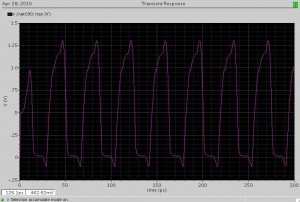Verilog-A Implementation of a Physical Semiempirical Short-channel MOSFET Compact Model with Self-consistent Terminal Currents and Charges
In commercial circuit simulators, behavioral blocks can be specified using Verilog-A, a language designed for describing analog circuits. For the behavioral blocks, the relationships of the currents and voltages at the terminals and internal nodes can be specified using mathematical and logical functions. Compact dynamical models for devices and systems can be described using the mathematical and logical functions. Verilog-A provides a simple method of integrating and simulating within commercial simulators such compact dynamical models as part of complex circuits.
In this project, Verilog-A was used to implement a simple, semi-empirical, charge-based, short-channel MOSFET [1] in the commercial simulator, Spectre. The MOSFET model relies on only ten parameters, all of which are physically meaningful, so it is suitable for technology benchmarking and performance projection. To implement the model in Verilog-A, the four terminals corresponding to the drain, gate, source, and body, plus an internal node were used. The four-terminal model is entirely symmetrical and computes the channel current based on the channel charge at the virtual source as related to the terminal voltages, as described in [1]. The internal node was used to determine the displacement currents that flow into the other four terminals due to intrinsic charges associated with them that are calculated by quasi-static equations. Because the model is charge-based, the intrinsic terminal currents equations are automatically consistent with the current equation and the model is charge-conservative. The intrinsic charge displacement currents were determined by differentiating the charge equations in time and fixing the value of the derivative as the current from each terminal to the internal node. A ring oscillator was simulated in Spectre using the Verilog-A implementation of the model for a typical 65-nm CMOS technology [2]. A waveform from this simulation is shown in Figure 1. Comparison with a BSIM4.3 of the same technology shows excellent agreement.
References
- A. Khakifirooz, O.M. Nayfeh, and D.A. Antoniadis, “A Simple Semiempirical Short-Channel MOSFET Current-Voltage Model Continuous Across All Regions of Operation and Employing Only Physical Parameters,” IEEE Transactions on Electron Devices, vol. 56, no. 8, pp. 1674-1680, August 2009. [↩] [↩]
- http://www.eas.asu.edu/~ptm/ [↩]
